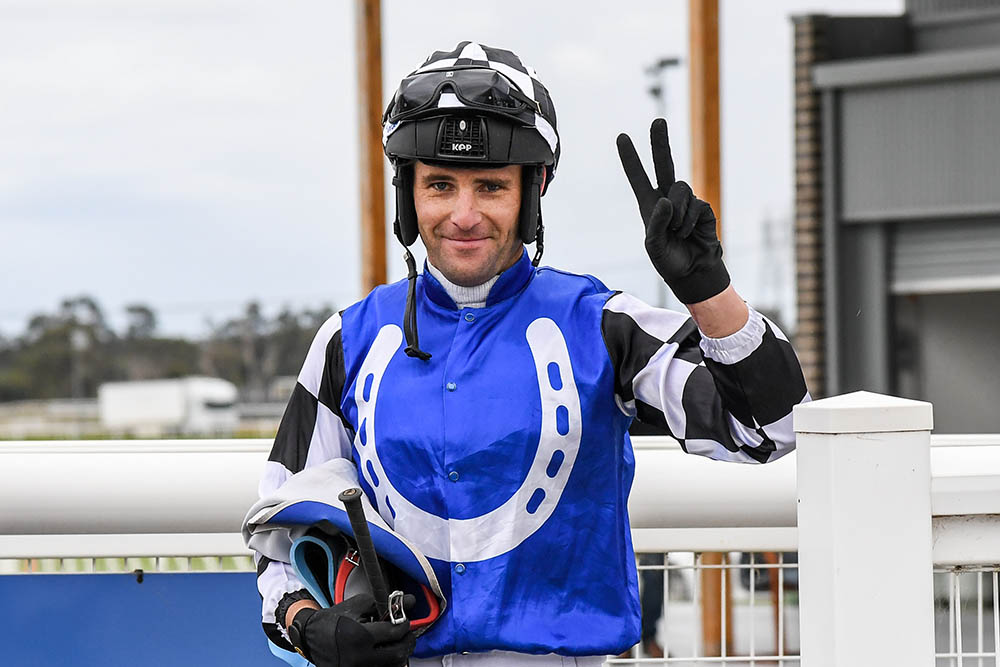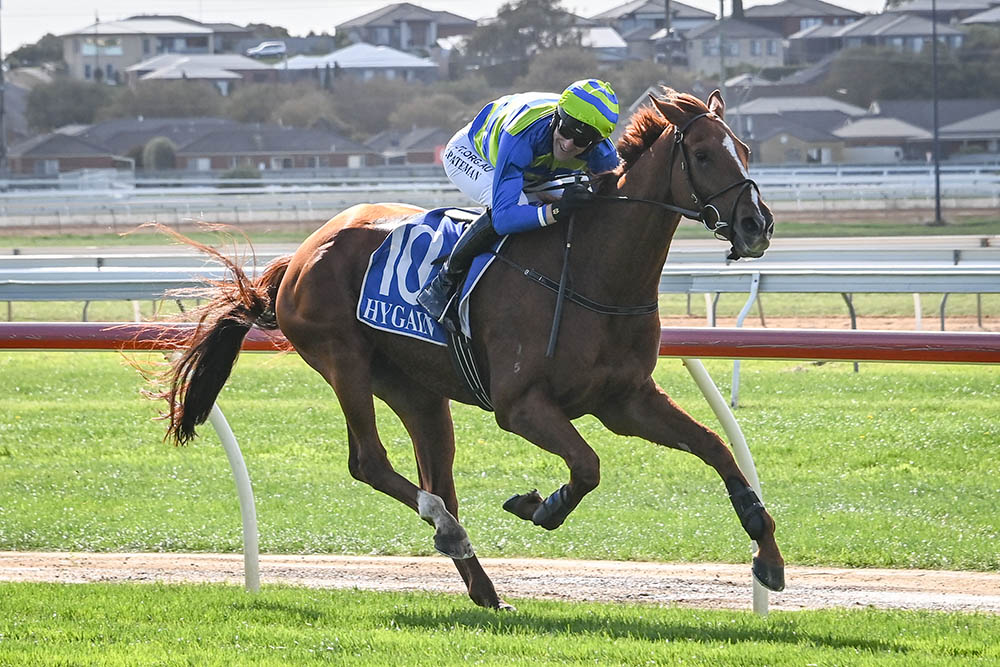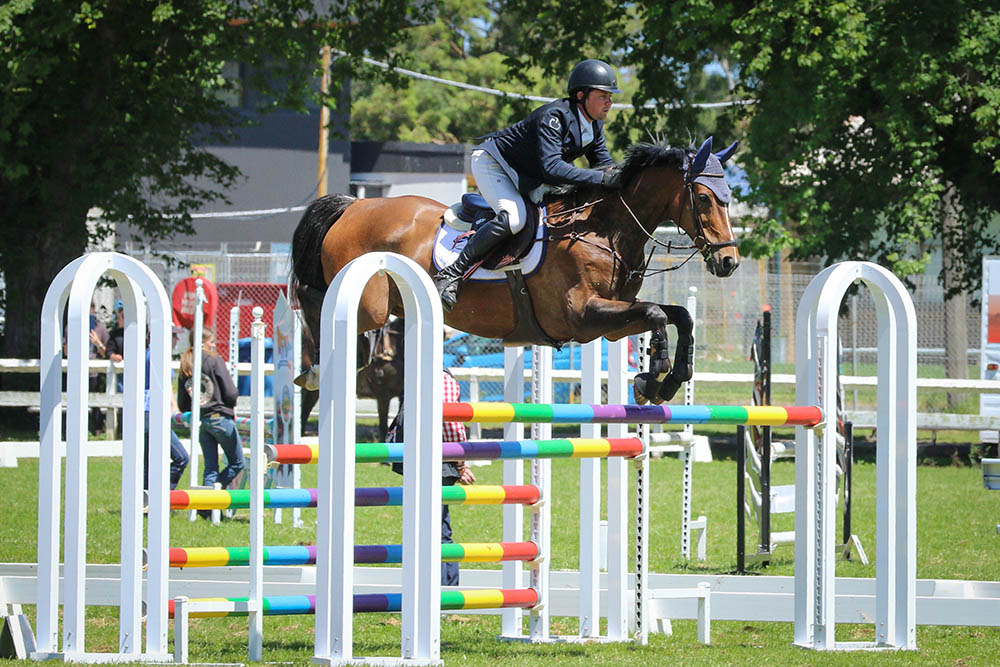The best jockeys know about the importance of ‘soft hands’, along with the best showjumpers, eventers and dressage riders. Because a horse’s mouth is so sensitive, that gentle touch is essential to building a trusting relationship.

Isn’t it great to be back at shows after all these lockdowns? Haven’t you missed it? Missed the chance to chew the fat at the end of the day just talking about horses?
Well, there we were socialising after the first day of showjumping held in Victoria for months. Still in the spring racing carnival time and just enjoying the opportunity to be together. A certain amount of alcoholic beverages had been consumed. Some elbows bumped as two men reached for the same bottle. And there we were talking about the importance of “soft hands” and how to achieve them.
Steven Pateman is the dominant jumps jockey in Australia, having won nine JJ Houlihan Championships — the equivalent of the Brownlow Medal for jumps jockeys. He has won the Great Eastern Steeplechase six times, the Grand Annual three times and been successful in Ireland, England and the USA. He is a leading race trainer. So I sat up and listened when he opened up the topic by talking about how important it was to have soft hands and how keeping your elbows by your side was absolutely necessary to enable soft hands. International showjumper Phillip Lever agreed, and it was so interesting to hear them chat not only about how important it was to have soft hands, but the importance of rider position to achieve that softness. The elbows must be in so the hand is free to move with the horse’s mouth in a smooth and consistent way — the whole arm moving from the shoulder to allow the hand to follow the mouth and maintain an even and soft contact that can respond to the horse and reward the horse.
I caught up with Steven afterwards to find out more about what he thought about soft hands. “It’s really important to have soft hands,” he says. “When you first get on a new horse, the first thing it’s going to think is about its mouth. So, it’s your chance to build a good relationship with the new horse through your hands, to reward it.” Of course, jockeys are riding a lot of different horses, and need to establish some sort of rapport quickly. He emphasises this point: “It’s important for a racehorse to be relaxed, especially stayers. They need to breathe properly, and to breathe properly they need to be relaxed. It’s no good if their tongue is rolled back in their mouth. They need to be keen, but they need to be relaxed,” Steven explains. This is why it is so important to have good hands. Soft hands help the horse feel relaxed.

“When I started out at Lindsay Park in South Australia there was a woman who rode trackwork on all the good horses, all the big stallions,” Steven continues. “She weighed 38kg. She could hold them all, no problems. That really taught me that it’s not about strength. You can’t out-strength a racehorse.” Well, actually that is obvious when you think about it. Steven explained further: “With a racehorse, the first thing you use to get a horse to go faster is the reins — you shorten your reins and move your hands up the neck. The last thing you use to make them slow down is the reins.” Now, this is a bit counterintuitive but does make sense when you think about it (and might be of particular interest to racehorse retrainers to understand that racehorses are trained to go faster when you release the reins. When they start a career in sport, they are likely to need to learn to NOT speed up when the reins are released). And it’s the same with a trained dressage horse in that you use your body and your core specifically to balance, collect and slow the horse before you use the reins.

CORRECT POSITION
So what makes soft hands possible for a jockey? “Well, it starts with a correct position,” says Steven. “Your body position must be secure, everything should look good. I started out riding show hacks, so I learned good basics. ‘Heels down, elbows in’. I think about it every time I ride. ‘Does it look good’?
“We teach young jockeys to use a neck strap to help them learn where to carry their hands, to keep the rein short. (Using the neck strap ensures that young jockeys are not balancing on the horse’s mouth.) A short rein makes for a softer hand. You should ride a racehorse with low hands. But sometimes a horse likes it better if your hands are a bit higher, so you do have to adapt to the horse. Jockeys often ride with a full bridge, but jump jockeys need to be able to adjust the length of rein very fast, so I ride with a half-bridge. I want my hands to be level and in the middle of the neck at that moment that he leaves the ground to jump. Then I can help him stay straight.”
With a full bridge, both reins go through both hands; in a half-bridge one rein goes through both hands. This protects against dropping a rein and can help stabilise the hands. This is a fundamental skill; we should all be able to ride with bridged reins. “All the top jockeys have soft hands,” says Steven. Did you watch the Melbourne Cup? Winning jockey James McDonald showed this beautifully when standing in the stirrups in perfect balance, overcome with emotion, riding with one hand as Verry Elleegant slowed down after the race.
Phil Lever offered another perspective. “Right from when a small child starts to walk it is natural for us to use our hands to balance. You put your hands out to catch yourself if you lose your balance. You grab something for balance. It’s natural, but riders must be in balance.” Phil recommends riding without stirrups or being lunged to build better balance. He says he teaches riders that they must hold the rein firmly with the thumb on the pointing finger, so the rein doesn’t slip through the hand, but the rest of the fist can be soft and responsive to the mouth.
For jumping riders, he says the thumb should point towards the mouth. This helps riders keep their elbows in, and is different from dressage riders whose thumbs should “kiss” — point towards each other — so the wrist is flexed and therefore soft. Phil points out that hands are soft when they are able to give sensitive aids: a soft aid, followed by a medium aid, before a strong aid. “Riders should not forget the medium aid,” he says. “Never just go from a soft aid to a strong aid, the medium strength aid is important.”
Steven talks about good hands being the way to a good relationship with the horse. For me, trust is a really important part of that relationship too. Trust is built up over time with positive experiences. The horse must trust that the hand will be soft and responsive. The mouth is such a sensitive part of the horse and we can have a very delicate conversation with our hands. We want the horse to reach into the contact, just as we want him to want to reach into the relationship with us. I love that a synonym for contact is connection, and our rein contact really equates with our psychological connection.
WHAT ARE ‘SOFT HANDS’?
So, what are soft hands? They are hands that can maintain a light, even contact with the mouth and can give quickly to reward the reaction you want. The hands should be able to be still in relation to the mouth. They should not be fixed still in a stiff way, but still in relation to the rider’s body. At walk and at canter the horse’s mouth will normally move forward and back in relation to the wither, where the hands are. So the hands will move more at walk than at trot. You can practise at walk just trying to keep the contact absolutely constant. You will notice your hands have to go forwards and back. The bigger the walk, the more your hands will move.
Soft hands are only possible if your position on the horse is stable and secure. You must be in self-carriage yourself, not using the reins to balance. As the horse moves, is your centre of gravity still? Develop this with work on the lunge or try to stand in the stirrups at walk and not overbalance. Try to rise for two steps and sit for one step in trot, without using the reins to balance. Keep your heels down to stabilise your position and engage those deep core muscles. Practise riding with very long reins, on the buckle, to ensure that you are not using the reins for balance and that you have an independent seat.
You should always hold the reins with a closed fist. You can relax your fist but not open your fingers. Correct position will take the strength out of your hand. Reins between ring and little fingers, thumbs on top stabilising the rein, but with a bent thumb. Wrists softly bent so the knuckles face each other. Gloves are good to protect your hands, but I don’t think they make much difference to the contact. Elbows bent and by your side, straight line from elbow to the mouth. The elbow should be relaxed so the hand is free to softly follow the mouth. Shoulders down, shoulder blades sliding down the back so the point of the shoulder blade points toward the pelvis.
A soft hand is independent of the seat for a balanced rider. A soft hand is a responsive hand that can give a range of aids, and will release or reward quickly.
And these are the conversations that happen when we all get together. So much of horsemanship is universal to all disciplines. We are all richer for sharing our perspective. EQ
Have fun!
READ MORE BY DR KERRY MACK:
Ask Less, Reward More – Equestrian Life, October 2021 issue
So You Want To Go To The Games? – Equestrian Life, September 2021 issue
The Ins & Outs Of Bitless Bridles – Equestrian Life, July 2021 issue
Taking The Plunge With The Lunge – Equestrian Life, June 2021 issue
Dressage for Showjumpers – Equestrian Life, May 2021 issue
23 Shoulder-In Exercises to Improve Your Horse – Equestrian Life, April 2021 issue
Understanding Your Horse’s Inner Thoughts – Equestrian Life, March 2021 issue
Make the Most of Your Seniority – Equestrian Life, February 2021 issue
Building Better Relationships – Equestrian Life, January 2021 issue
Whipping Up Controversy – Equestrian Life, December 2020 issue
The Importance of a Trusting Relationship – Equestrian Life, November 2020 issue
Welcome to Kindergarten for Foals – Equestrian Life, October 2020 issue
The Carrot or the Liquorice? Positive Reinforcement – Equestrian Life, September 2020 issue
Submission or Stress? Something to Chew On – Equestrian Life, August 2020 issue
A Relaxed Horse is a Happy Horse – Equestrian Life, July 2020 issue
The Literate Horse Rider – Equestrian Life, June 2020 issue
Why Horses Love Ingrid Klimke – Equestrian Life, May 2020 issue





